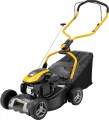Features
-
Self-propelled. In self-propelled lawn mowers, the engine rotates not only the cutting tool, but also the wheels of the lawn mower; thus, the user does not need to push it in front of him - it is enough just to set and control the direction of movement. This is convenient, but such models are more expensive than non-self-propelled ones. This is due not only to the complexity of the design, but also to the fact that such devices require more powerful engines - after all, power must be divided between the cutting nozzle and the chassis. For the same reason, a self-propelled unit will be less productive and efficient than a non-self-propelled analogue of the same power. However, some types of lawn mowers are by definition self-propelled - in particular, these are heavy professional models that would be difficult to push with your hands, as well as
mini tractor riders(see "Type").
-
Height adjustable handle. Possibility of height adjustment of the lawn mower handle, which allows to optimally adjust the device to the height of the user. This feature is especially useful for short or, conversely, tall people - by default, lawn mower handles are made for medium height, and it would be inconvenient to work with the unit without height adjustment.
-
Piano wheels. The lawn mower has special, so-called. caster wheels (similar to th
...ose used, for example, in supermarket carts). These wheels automatically turn in the direction of movement of the device, which significantly reduces the turning radius of the lawn mower and increases its maneuverability. At the same time, it is worth noting that this design is usually used only for the front wheels, while the rear ones remain rigidly fixed to the axle. So moving such a structure sideways still does not work.
- Flushing fitting. The presence of a fitting in the lawn mower for connecting a garden hose; usually such a fitting is located on the deck and is designed for a standard connector used in hoses. In accordance with the name, this function allows you to rinse the deck and blade of the unit, removing grass residues and other contaminants from them: just connect the hose, turn on the working nozzle and give water. This is much more convenient than removing the deck and washer blade by hand - especially when it comes to a heavy professional mower or rider (see "Type").
- Cup holder. The presence of a cup holder in the design of the lawn mower - a specialized stand for glasses and relatively small bottles. Such a stand usually has a characteristic recess where a container with a drink for the operator is installed. Often, cupholders are made in pairs, they are placed on a separate panel between the tubes of the handle of the unit. There are coasters in traditional lawn mowers and riders (mini tractors).Wheel drive
Type of drive provided in the self-propelled lawnmower (see "Features"). This moment is indicated depending on which wheels the thrust from the engine is output to.
— Rear. The classic version used in the vast majority of self-propelled devices. Such popularity is due to a number of advantages. Firstly, the rear wheels are located behind the cutting system, and when moving, they ride on already cut grass. Secondly, the main part of the weight in classic design lawn mowers falls on the rear wheels; and if the bag is used at the rear of the machine, then the centre of gravity is even more shifted back. However it is believed that such devices are less manoeuvrable than front-wheel drive; however, in most cases, this moment is not decisive, in addition, the design often provides for various tricks that make it easier to turn.
— Front. It is believed that front-wheel drive gives the lawn mower better steering. And mini tractors of this design are also less likely to get stuck in streams, puddles and other similar places: a front-wheel drive unit can slip through a difficult section by inertia, so that the front wheels catch on hard ground, while a rear-wheel drive machine is more likely to “sit down” with the drive wheels in sticky earth. On the other hand, in general, this option is less suitable for lawn mowers than rear-wheel drive — primarily because the drive wheels have to move on uncut grass (the only exception is some riders in which the cutting system...is mounted in front of the machine). In addition, for reliable traction with the ground, the centre of gravity of the device must be shifted forward. This is especially difficult to achieve if a rear-mounted bag is used to collect grass: as it fills, the weight shifts from the front axle to the rear, which in some cases can lead to loss of traction. As a result, front-wheel drive is extremely rare, mostly in bagless models and/or with the engine shifted noticeably forward for proper weight distribution.
— Full. In this case, full means 4-wheel drive at once. Its main advantage is its excellent cross-country ability: the unit “clings to the ground” with all four wheels, and the likelihood that they will all get stuck at once is extremely low. In addition, the design may provide specific features that further increase cross-country ability — for example, a differential lock. On the other hand, all-wheel drive is expensive both in itself (due to the complexity of the design) and in operation (due to high fuel consumption). The only exceptions are small electric robotic mowers (see "Type"), but they are produced in relatively small numbers — most 4x4 models have gasoline engines and are manually controlled. In light of all this, it makes sense to pay attention to this option only when you have to work on a vast area with difficult terrain, with which a “single-drive” unit cannot cope normally. But buying an all-wheel drive model for a flat lawn in front of a private house is hardly justified.

